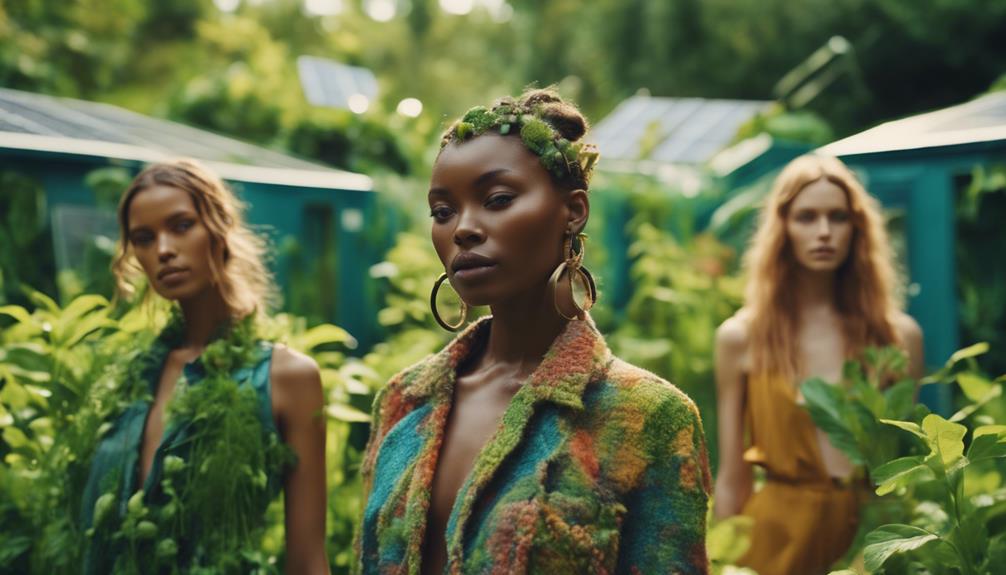The phrase has been rephrased below:
Sustainable fashion is unquestionably becoming more popular! The industry, which is worth more than $6.5 billion, is expected to reach $15 billion by 2030. Consumers are the driving force behind this shift, with 80% of millennials willing to spend more on sustainable brands. Moreover, 75% of Gen Z prefer second-hand clothing, highlighting their environmentally conscious mindset. The growth rates indicate that sustainable products are growing 5.6 times faster than traditional options. As awareness of sustainability continues to grow, more people are choosing sustainable options in their shopping habits. Stay tuned to discover even more surprising facts about this developing trend!
Key Takeaways
- The sustainable fashion market is projected to grow from $6.5 billion to $10.1 billion by 2025, indicating significant increasing popularity.
- 80% of millennials in the US are willing to invest more in sustainable brands, reflecting a shift in consumer preferences.
- Thrift shopping is growing three times faster than overall fashion sales, showcasing the rising interest in second-hand clothing.
- 55% of consumers express intentions to purchase sustainable clothing, highlighting growing awareness and demand for eco-friendly options.
Sustainable Fashion Industry Overview
The sustainable fashion industry, valued at over $6.5 billion, is rapidly evolving and projected to reach $10.1 billion by 2025. This growth reflects a significant shift in consumer preferences toward sustainable products. You'll notice more eco-friendly clothing options on the market, as brands adapt to meet the rising demand. It's not just about style; it's about making ethical fashion choices that positively impact the planet.
As consumers become more conscious of their purchasing decisions, the importance of sustainable textiles rises. You'll find that these materials aren't only better for the environment but are also gaining traction in mainstream fashion. The eco-friendly clothing segment alone is projected to grow by $1.57 billion by 2025, emphasizing the shift towards sustainability.
Moreover, ethical fashion is expected to grow at an average rate of 8.3% annually, indicating that you're not alone in valuing responsible fashion choices. This evolution means you'll have access to a broader range of sustainable products, aligning your wardrobe with your values and contributing to a more sustainable future.
The transformation happening now isn't just a trend; it's a movement toward a more ethical and environmentally-friendly fashion industry.
Growth Rate and Market Dynamics

As sustainable fashion continues to gain traction, understanding its growth rate and market dynamics reveals the broader implications of this shift in consumer behavior.
The ethical fashion market is currently growing at an impressive average rate of 8.3% annually, with projections indicating it could escalate to 9.7% by 2030. This growth rate highlights a significant transformation in consumer preferences, as sustainable products are expected to grow 5.6 times faster than their non-sustainable counterparts.
Regions play a vital role in this evolution. The Asia Pacific region holds 36% of the global ethical fashion market, showcasing its importance in driving growth. Meanwhile, Europe leads the charge in sustainable fashion adoption and innovation, setting benchmarks that influence practices in other areas. In North America, you can see a rising demand for sustainable options, reflecting a growing awareness of the environmental impacts associated with traditional fashion choices.
This confluence of factors suggests that the sustainable fashion market isn't just a passing trend; it's a lasting movement that aligns with evolving consumer values. In fact, sustainable fashion industry statistics show that the market is experiencing significant growth, with more consumers seeking out eco-friendly and ethically-produced clothing. Many major fashion brands are also shifting towards more sustainable practices in response to this growing demand. As more people become aware of the environmental and social impact of their purchasing decisions, it’s likely that the sustainable fashion movement will continue to gain momentum in the years to come.
As you navigate this market, staying informed on these dynamics will be essential.
Demographics of Sustainable Fashion Consumers
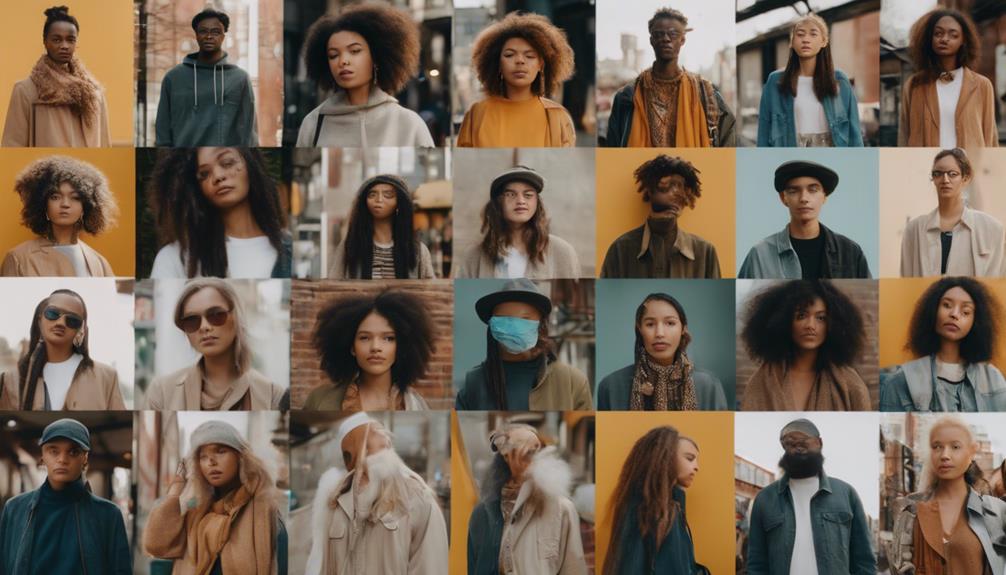
Young and middle-aged men are stepping up as key players in the sustainable fashion movement, showcasing a shift in consumer demographics toward eco-friendly choices. This change reflects a growing recognition of the impact of fashion on the environment, moving away from the fast fashion mentality.
Here are some significant trends among sustainable fashion consumers:
- Gen Z's Commitment: A staggering 75% of Gen Z opts for pre-owned clothes, actively minimizing consumption and promoting sustainability.
- Millennials Willingness: About 80% of millennials in the US are ready to invest more in sustainable brands, illustrating their desire for eco-friendly options.
As these demographics evolve, sustainable fashion is no longer just a niche market.
You're witnessing a transformative movement where individuals prioritize eco-friendly choices, leading to a more responsible fashion industry.
With young men, Gen Z, and millennials championing sustainable brands, the future of fashion looks increasingly green.
Consumer Interest and Awareness
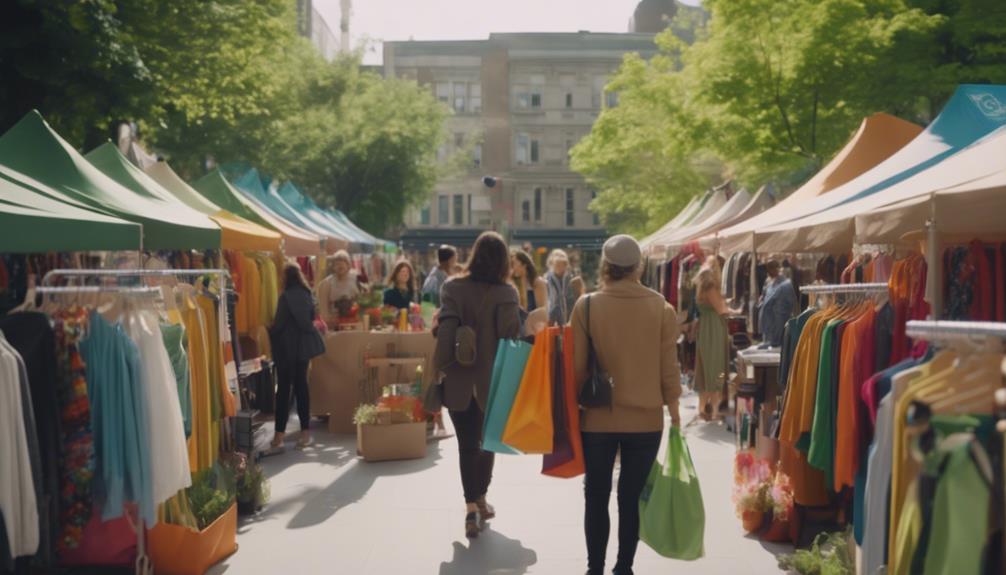
You're likely noticing a surge in consumer awareness about sustainability in fashion, with many of you actively seeking eco-friendly options.
This growing interest isn't just a trend; it reflects a deeper understanding of the impact of your purchasing choices.
As educational initiatives spread, you might find yourself more informed and empowered to make sustainable decisions.
Rising Consumer Awareness
Consumer awareness of sustainability in fashion is surging, with 72% of US shoppers now recognizing the importance of eco-friendly practices. This rising consumer awareness is reshaping the fashion landscape, creating a significant demand for eco-friendly options. As you navigate this evolving market, you'll notice that many sustainable fashion brands are stepping up to meet your needs.
55% of consumers express interest in purchasing sustainable clothing, indicating a strong preference for ethical choices.
69% of Vogue readers prioritize sustainability, showcasing how influential fashion media can drive awareness and shift purchasing habits.
73% of British consumers who buy sustainable clothing also opt for second-hand items, highlighting a trend towards circular fashion practices.
Despite this growing awareness, 48% of shoppers still feel unsure about where to find sustainable brands. This gap suggests that the industry must improve transparency and accessibility to make sustainable choices easier for you.
As more people recognize the link between their fashion choices and environmental issues, the push for sustainable clothing will only grow stronger, paving the way for a more responsible fashion future.
Sustainable Purchasing Intentions
A growing number of shoppers aren't only aware of sustainability issues in fashion but also enthusiastic to make eco-friendly purchases. In the US, 72% of consumers recognize these issues, and 55% express sustainable purchasing intentions, showing a strong desire to buy sustainable fashion. This trend reflects a significant shift in consumer interest towards ethical choices.
In the UK, 73% of those who buy sustainable fashion also engage in second-hand shopping, indicating a commitment to reducing consumption and waste. However, there's still a notable gap in accessibility; 48% of consumers aren't sure where to find sustainable brands. This highlights the challenges that remain in connecting eco-conscious shoppers with the products they seek.
Interestingly, 69% of Vogue readers prioritize sustainability in their purchasing decisions, suggesting that media influence plays a vital role in shaping consumer preferences. As more people become aware and engaged, the demand for sustainable options continues to rise.
If you're looking to make a positive impact, exploring sustainable fashion and second-hand shopping can be an excellent start.
Influence of Education Initiatives
Education initiatives play a significant role in shaping consumer interest and awareness about sustainable fashion, helping shoppers navigate their options and make informed choices. With 72% of US consumers now aware of sustainability issues in the fashion industry, it's clear that education is transforming consumer behavior. As you explore sustainable brands, you'll find that awareness campaigns and workshops are essential in guiding your decisions.
55% of consumers express interest in purchasing sustainable clothing, reflecting a growing demand for eco-friendly options.
48% of shoppers are unsure where to find sustainable brands, highlighting the need for better educational resources.
69% of Vogue readers prioritize sustainability, showcasing the strong influence of education on fashion-centric audiences.
These statistics emphasize the importance of education initiatives in fostering a more informed consumer base. By engaging with these resources, you can better understand the impact of fast fashion and the significance of your choices.
As you become more aware, you'll be empowered to support sustainable brands and contribute to a positive change in the fashion industry.
Environmental Impact of Fast Fashion

Fast fashion isn't just about trendy clothes; it's a major contributor to pollution and waste.
You might be shocked to learn that it generates millions of tons of textile waste each year and consumes an alarming amount of water.
Understanding these impacts can help you make more conscious choices in your wardrobe.
Pollution and Waste Generation
The fashion industry's rapid growth has led to alarming pollution and waste generation, making it the second-highest global polluter after the oil industry. You might be shocked to learn that the fashion industry is responsible for 2-8% of global greenhouse gas emissions. Fast fashion contributes greatly to this issue, generating around 92 million tons of textile waste each year, with only 1% being recycled into new garments.
Here are some key points to reflect on:
- Every second, a truckload of textile waste is dumped in landfills.
- The average piece of clothing is worn only 7-10 times before being discarded.
These alarming statistics highlight the environmental impact of fast fashion.
To combat this crisis, adopting sustainable practices is essential. By choosing more eco-friendly options and supporting brands committed to reducing pollution and textile waste, you can help shift the narrative toward a more sustainable future.
It's time to rethink your fashion choices and contribute to a healthier planet.
Water Consumption Concerns
You might be surprised to learn that the fashion industry uses a staggering 93 billion cubic meters of water each year, making it the second most water-intensive industry in the world. This excessive water consumption contributes considerably to environmental impact, with the industry accounting for 20% of global wastewater. When you consider that producing a single pair of jeans requires around 2,000 gallons of water, it becomes clear how quickly resources are depleted.
Cotton production, a staple in clothing production, is also highly water-intensive, demanding substantial amounts of water for cultivation. Furthermore, the dyeing and finishing processes introduce toxic chemicals, further exacerbating water pollution. These practices not only harm our water sources but also threaten ecosystems and public health.
To combat these issues, adopting sustainable materials in fashion is vital. By choosing brands that prioritize eco-friendly practices, you can help reduce water consumption and its detrimental effects. Supporting sustainable fashion means demanding change and encouraging the industry to adopt responsible practices that prioritize our planet's resources. Together, we can lessen the environmental impact of the fashion industry and promote a healthier future.
Waste Generation and Pollution
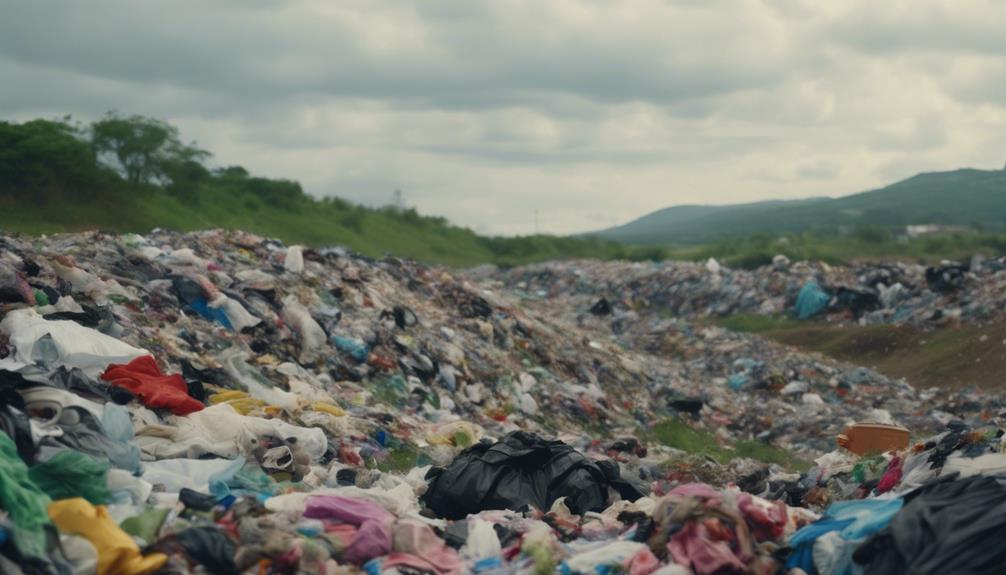
Fashion waste is a pressing issue, with the industry generating around 92 million tons of textile waste annually. This staggering amount highlights the urgent need for change, especially given that only 1% of clothing gets recycled into new garments. You can see how fast fashion contributes to waste generation, filling up landfills at alarming rates.
Each second, one truckload of textile waste is created. The fashion industry accounts for 20% of global wastewater. Producing a single pair of jeans requires about 2,000 gallons of water.
The impact doesn't stop at waste; it extends to water pollution as well. The production processes in fashion lead to severe contamination of waterways, affecting ecosystems and communities.
As you consider these issues, it's clear that sustainable fashion isn't just a trend but a necessity. By choosing eco-friendly materials and supporting brands committed to reducing waste, you can play a part in mitigating this environmental crisis. Your choices matter, and they can help shift the industry towards a more sustainable future, reducing both textile waste and water pollution.
Consumer Behavior Trends
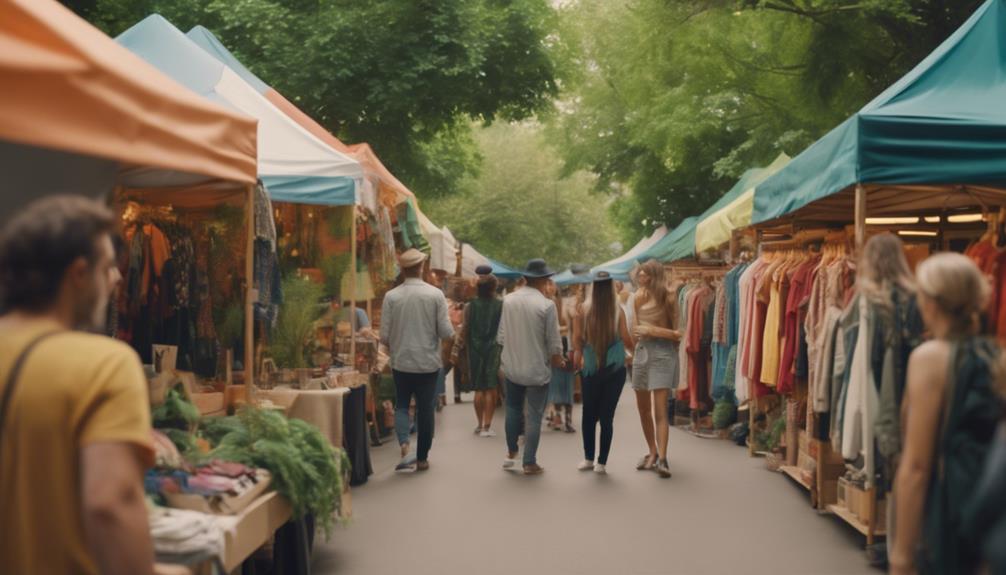
Consumers are increasingly prioritizing sustainability in their shopping habits, with a growing number willing to invest in eco-friendly brands. This shift in consumer behavior is reshaping the fashion landscape. For instance, 72% of US consumers are now aware of sustainability issues, and 55% express interest in purchasing sustainable clothing.
The trend is especially pronounced among young adults, with 80% willing to pay more for sustainable brands. You might also notice that thrift shopping is surging, growing three times faster than overall fashion sales. This indicates a clear preference for secondhand and circular fashion.
Here's a quick look at some compelling statistics:
| Consumer Insight | Percentage | Trend |
|---|---|---|
| Aware of sustainability issues | 72% | Increasing awareness |
| Willing to pay more for eco-friendly brands | 80% | Commitment to sustainability |
| Purchasing second-hand clothing | 73% | Emphasis on reuse |
| Vogue readers prioritizing sustainability | 69% | Media influence on consumer choices |
With these changes, it's clear that consumers are not just talking about sustainability; they're actively making choices that reflect their values.
Future Projections for Sustainable Fashion

As sustainability gains traction in consumer choices, the future of sustainable fashion looks promising, with significant market growth and job creation on the horizon.
The sustainable fashion market is projected to grow from over $6.5 billion to $10.1 billion by 2025, and further to $15 billion by 2030. This shift reflects evolving consumer preferences, as sustainable products are expected to grow 5.6 times faster than traditional options.
You can expect to see:
- An annual growth rate of 8.3% in ethical fashion, potentially increasing to 9.7% by 2030.
- The eco-friendly clothing sector alone is estimated to add $1.57 billion by 2025, signaling strong economic potential.
With these projections, it's clear that the sustainable fashion industry not only aligns with eco-friendly values but also paves the way for substantial economic growth and job creation.
Embracing sustainable fashion isn't just a trend; it's a movement that's reshaping the future of fashion as we understand it.
Frequently Asked Questions
Is Sustainable Fashion Becoming More Popular?
Sustainable fashion's popularity is undeniable. You're noticing more brands focusing on eco-friendly practices, and consumers like you are increasingly choosing sustainable options. This shift reflects growing awareness and a commitment to ethical clothing choices.
Are Sustainable Products Becoming More Popular?
Sustainable products are rising like a tide, reshaping consumer preferences. You're seeing more people enthusiastic to invest in eco-friendly options, with many willing to pay extra for brands that prioritize sustainability in their practices.
Is the Sustainable Fashion Industry Growing?
Yes, the sustainable fashion industry's growing rapidly. You'll see its value increase considerably, driven by your demand for eco-friendly options. With trends shifting, it's clear that consumers like you are prioritizing sustainability more than ever.
How Many People Want Sustainable Fashion?
You'll find that 55% of US consumers want sustainable clothing, with 73% of British buyers also opting for second-hand. This indicates a notable shift towards environmentally conscious fashion choices among a growing number of shoppers.
Conclusion
As you stroll through a vibrant garden, each flower represents a choice you make in fashion.
Choosing sustainable options can transform that garden into a lush paradise, fostering a healthier planet.
Just like tending to your plants, your decisions shape the future.
The growth of sustainable fashion is a proof of your power as a consumer.
Together, let's cultivate a landscape where style and sustainability flourish hand in hand, proving that every choice can blossom into change.




